Facebook Ads Relevance score was the old method that used a rating of 1-10 points for each of your ads. The Relevance Score was based on the audience’s feedback and engagement with your ads.
In late 2019, Facebook replaced the Relevance Score with 3 new Ad Relevance Diagnostics metrics:
- Quality Ranking
- Engagement Rate Ranking
- Conversion Rate Ranking
So basically, instead of one 1-10 rating, you now have more comprehensive guidance for improving your ad results.
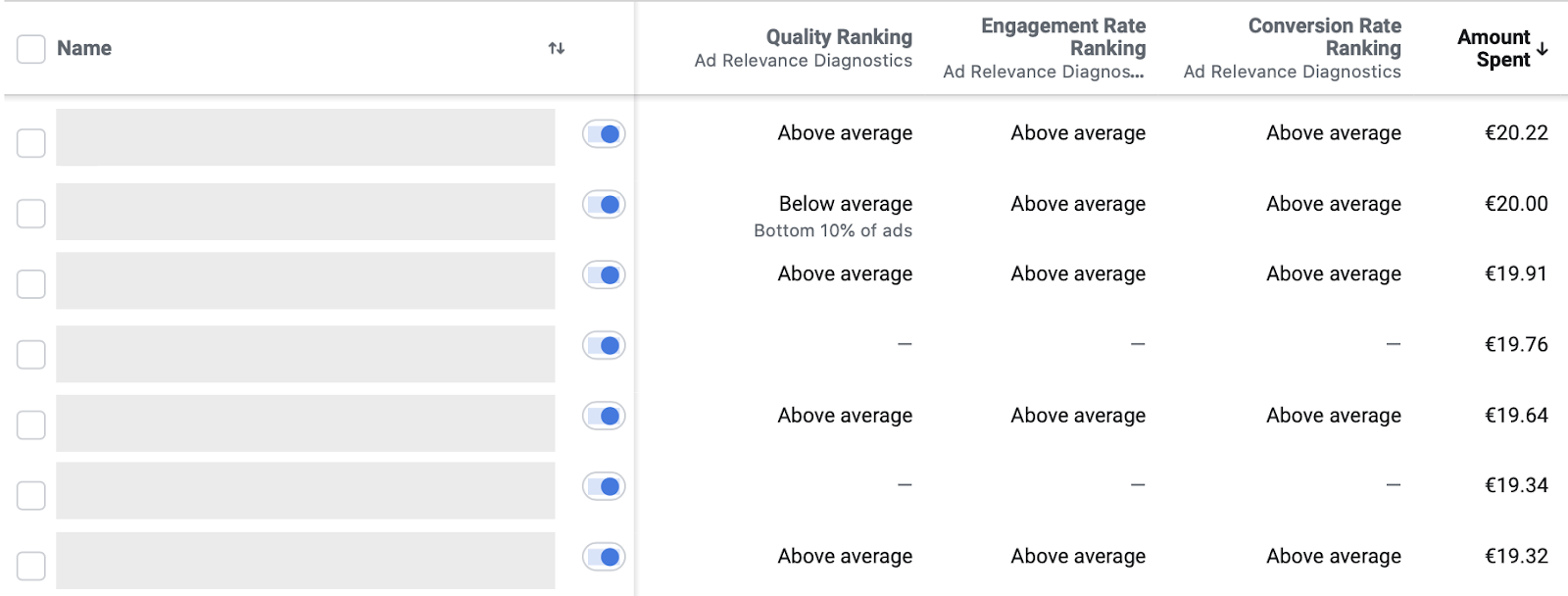
Facebook now has three quality metrics
When you search for “Facebook Ad Relevance Score” on Google, you can still find a lot of outdated articles on the topic. These guides can still be helpful for finding some tips to improve your ads’ Quality Ranking.
However, this guide will explain to you how the Facebook Ad Quality Score is calculated in 2020.
And we will share plenty of tips and advice for improving all your ad quality metrics (and for getting lower CPC and CPAs with your Facebook Ad campaigns.

Here’s to higher Facebook ad Quality Rankings! – Image source
Before we get to the tips, let’s take a look at each of the new Facebook quality metrics so we understand what they mean and how they’re calculated.
Facebook Relevance Score is now Ad Relevance Diagnostics
Your Facebook ads’ quality scores are important signals that will affect both your ad delivery and the price you pay for your Facebook campaigns.
Here’s how Facebook explains the logic behind ad relevance:
“People prefer to see ads that are relevant to them. And when businesses show their ads to relevant audiences, they see better business outcomes. That’s why we consider how relevant each ad is to a person before delivering an ad to that person. Ads that are more relevant cost less and see more results.
Ad relevance diagnostics can help you diagnose whether the ads you ran were relevant to the audience you reached.“
Higher ad relevance = lower cost-per-result = more results 🚀
AdEspresso conducted an experiment to understand how the relevance score affected their ads’ cost-per-click.
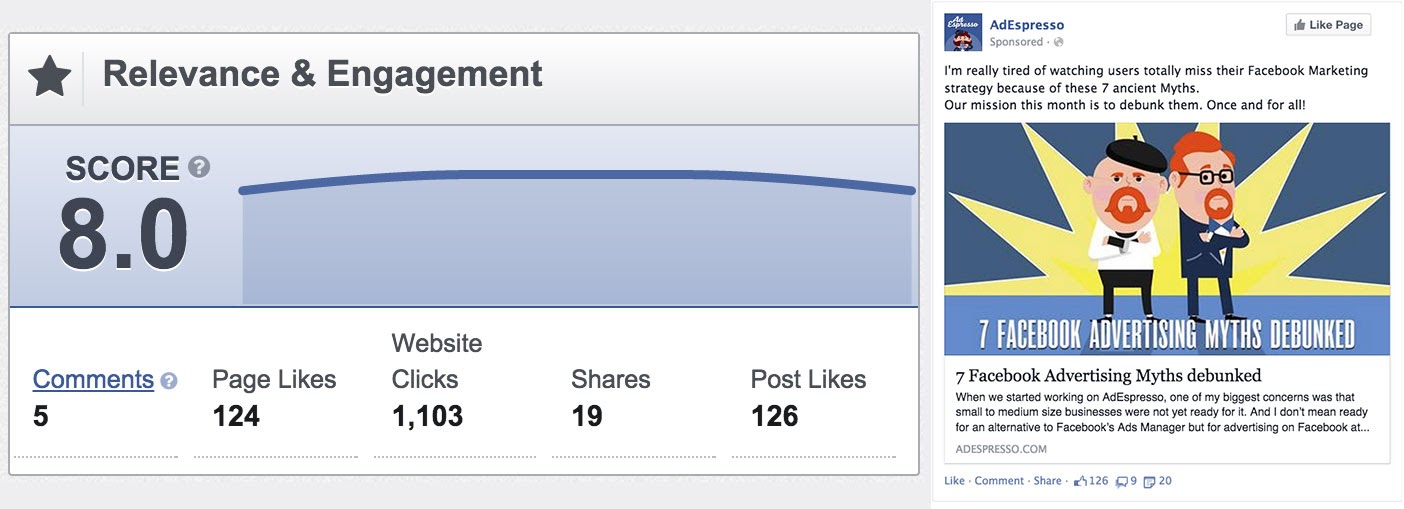
This AdEspresso ad had a high relevance score
One of their Facebook ads had a relevance score of 2.9 points and the other had 8.0 points.
The ad with a 2.9-point relevance score brought in an average cost-per-click of $0.142, while the ad with an 8.0 score had the CPC of $0.03. That’s a 400% lower CPC!! 🤩
If your campaigns aren’t meeting your advertising goals, you can use ad relevance diagnostics to understand whether you need to make adjustments to:
- Your creative assets (ad images and videos)
- Post-click experience (landing page, app store listing)
- Audience targeting (ad sets’ targeting)
For example, if these static image ads would have a low quality ranking…
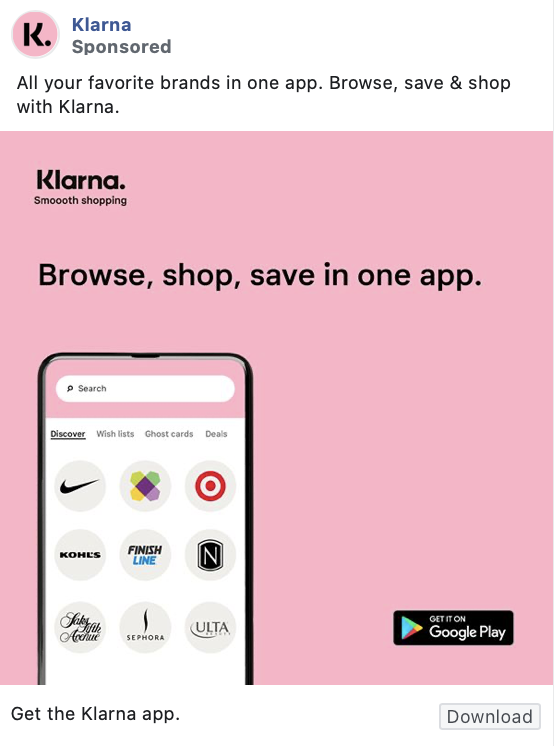
Klarna’s static image ad
Klarna could test out animated ad creatives to improve their ads’ quality ranking.

Klarna’s video ad
But let’s not jump ahead too far… Let’s explore each of the 3 metrics a bit more closely to understand how they’re calculated + learn some hacks and tricks to improve each of the scores.
💎 Facebook ad Quality Ranking and how to improve it
The Quality Ranking is assigned to each of your ads separately. You can see it in your ad reports in the Facebook Ads Manager.
It shows how your audience reacts when they see an ad and how they engage with the post-click experience. Your ad is ranked against ads that competed for the same audience.
In a way, Quality Ranking is the sum of two other quality metrics: Engagement Ranking and Conversion Rate Ranking.
Facebook also includes in the Quality Ranking calculations the number of times your ad was hidden and assessments of clickbait, engagement bait, and other negative experiences.
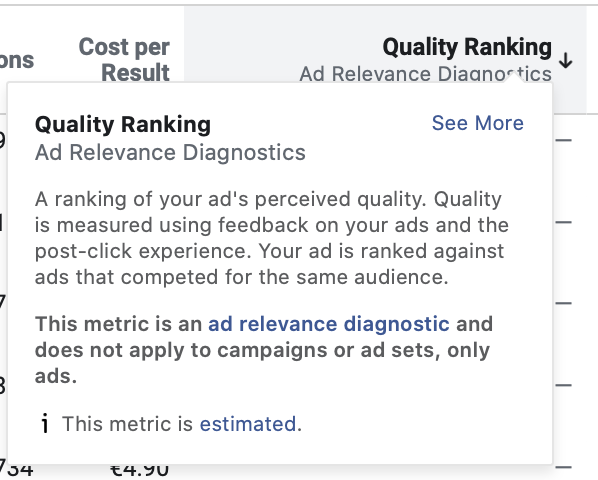
Facebook ad Quality Ranking
P.S. This metric is an ad relevance diagnostic and does not apply to campaigns or ad sets, only ads.
There are 5 different levels of Quality Score:
- Above average
- Average
- Below average (Bottom 35% of ads)
- Below average (Bottom 20% of ads)
- Below average (Bottom 10% of ads)
The “Above average” is the highest possible rating your ads can get. In our experience, ads that rank “Average” or “Above Average” are already an indicator of good performance.
If your ads have one of the “Below average” ratings (and if you’re unhappy with your Facebook ad campaign’s results), it means that you should work more on your ad creatives and landing page.
10 tips & hacks to improve your Facebook ads’ Quality Score
Boosting your ad-level Quality Scores is all about making your ad creatives more attractive and ensuring your landing page is well optimized.

Attractive ads make people want your product – Image source
Follow these 10 best practices to get closer to that “Above Average” score:
- Improve your Facebook ads’ copy and value proposition.
- Experiment with various discounts and limited-time offers.
- Add more call-to-actions into your ad creative.
- Test out new visual layouts and colors in your ad images.
- Make sure your ads are in the correct format for all possible placements.
- Double down on your ad creatives with higher quality scores.
- Give a try to new Facebook ad types.
- Test out Facebook video ads.
- Improve your landing page conversion rates.
- Make sure your landing page is mobile-responsive.
1. Improve your Facebook ads’ copy and value proposition
As a marketer, you are already aware that having the right value proposition is the key to your audience’s heart.
As the advertising legend D. Ogilvy put it:
“Not just words, not just product puffery, not just show-window advertising. Each advertisement must say to each reader: “Buy this product, and you will get this specific benefit.”
A golden example of this guidance is an advertisement that Ogilvy wrote for his client Sears: Shop at Sears and SAVE. Straightforward and clear.
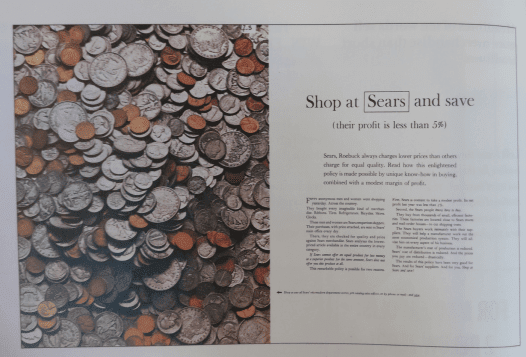
An advertisement written by D. Ogilvy – Image source
To further explore how you can improve your Facebook ads’ value proposition, let’s analyze these examples of two ads that look more or less the same…

These two ads look similar, but they’re actually very different
The ad copy looks more or less the same, right? However, these two ads would result in different Facebook ad quality scores and bring variated results.
If you look more closely, the ad on the left fails to deliver the key message in a clear and actionable way. It’s not about the customer – you – but the company (we).
On the other hand, the ad on the right is full of benefits and it talks about YOU, the viewer. On top of it, the ad tells the viewer to start their free trial right away – a clearly defined next step.
Small nuances in your Facebook ad copy can make a big difference.
To improve your ad copy, follow these rules:
- Focus on one key benefit per ad.
- Make sure the benefits are relevant and valuable to your target audience.
- Keep your ad copy short and clear (remove all unnecessary words).
- Include a clear call-to-action in the headline (what should the viewer do next?).
Here’s a good example by the online live streaming tool Restream that follows all the above best practices.
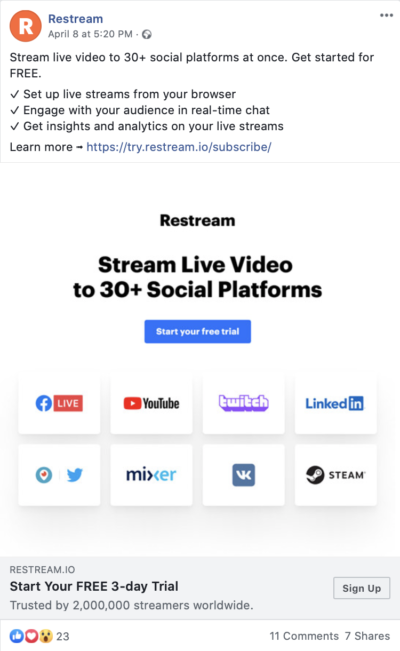
This restream ad is a good copywriting example
Extra tip: Always add your key value proposition to the ad image as well since this is the first copy people will read in your Facebook ad.
Consumer Acquisition has found that visuals are arguably the most important part of your Facebook ads. They’re responsible for 75%-90% of the overall ad performance. If your Facebook ad image fails to catch attention, nobody will ever read your amazingly well written ad copy.
2. Experiment with various discounts and limited-time offers
People love discounts and including a special offer in your ads can help to boost its engagement and click-through rates.
To give you a good example, here’s a Facebook ad by Virgin Airlines:
- It focuses on a special deal.
- This ad features an offer people care about.
- It includes all relevant information about the offer.
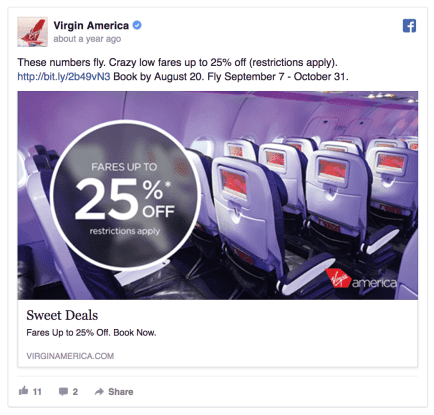
Add discounts to your Facebook ads
For more ideas for discount offers applied to Facebook ads, check out these 36 Facebook ad examples.
3. Add more call-to-actions into your ad creative
Facebook ads have a lot of different text boxes that you can fill in when setting up the ads:
- The main text
- The headline
- Link description
And all of them can be turned into actionable advice that nudges people towards the next step (be it a purchase, signup, or reading your blog article).
For example, Revolut’s Facebook ad text lists all their product’s benefits as action items. And the headline tells you what the next step should be: To start using the service, for free.
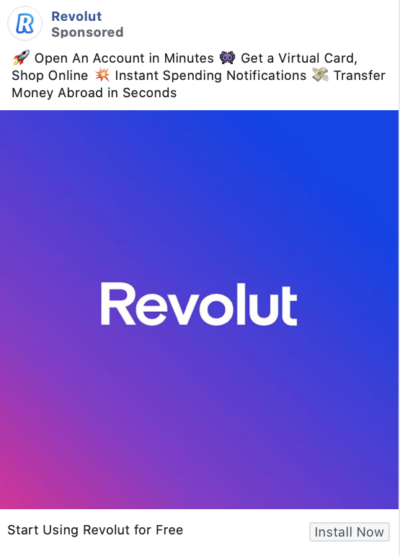
Revolut’s ad is highly actionable
Test adding a clear call-to-action to your Facebook ad’s headline, right next to the CTA button.
And as you include a call-to-action in your ad image, brand it in contrasting colors to make it highly visible.
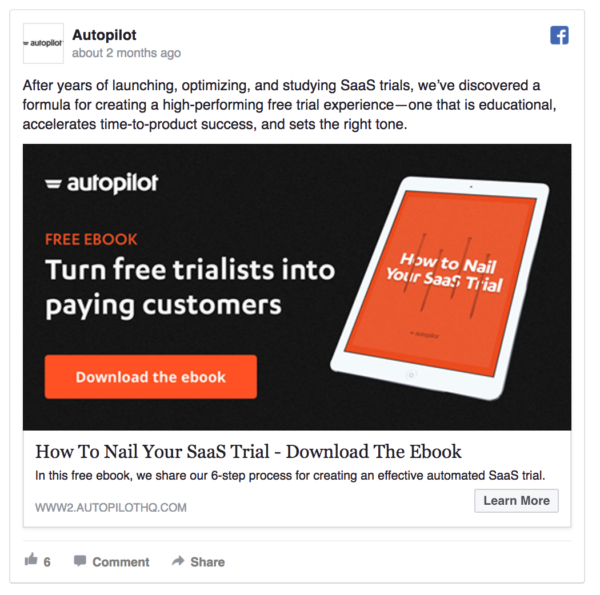
Like this ad by autopilot ☝
Extra tip: If you create a video ad, make sure to end it with a clear call-to-action.
We’ve seen many advertisers create amazing video ads that fail to convert. Quite often, the reason for this is that the video ad is missing a clear call-to-action.
Adding a CTA copy at the end of your video ads is especially relevant for Story-format ads as there won’t be any accompanying copy to tell the viewer what’s next.
Below is an example of the last 2 seconds in Quibi’s video ad: a clear indication of what the viewer should do next.
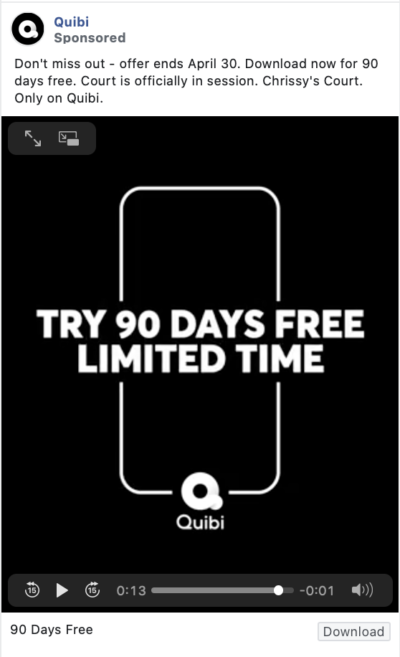
Quibi’s video ad ends with a call-to-action
Here’s a list of call-to-action message formulas that you can use:
- Try X free for X days.
- Get started now.
- Get started for free.
- Subscribe.
- Sign up.
- Get $X off your first order.
- Get a free e-book/course
4. Test out new visual layouts and colors in your ad images
Another efficient way to turn around poorly performing Facebook ad campaigns is to update their visuals.
After you have run your ads for a month, there’s a high chance that people are getting tired of seeing your ads.
Sometimes, switching up your ad image’s background can help to reduce the ad fatigue and improve your ads’ click-through rates.
For example, MeetFrank is regularly adding similar ads with multiple background versions to keep their ads fresh for the audience.
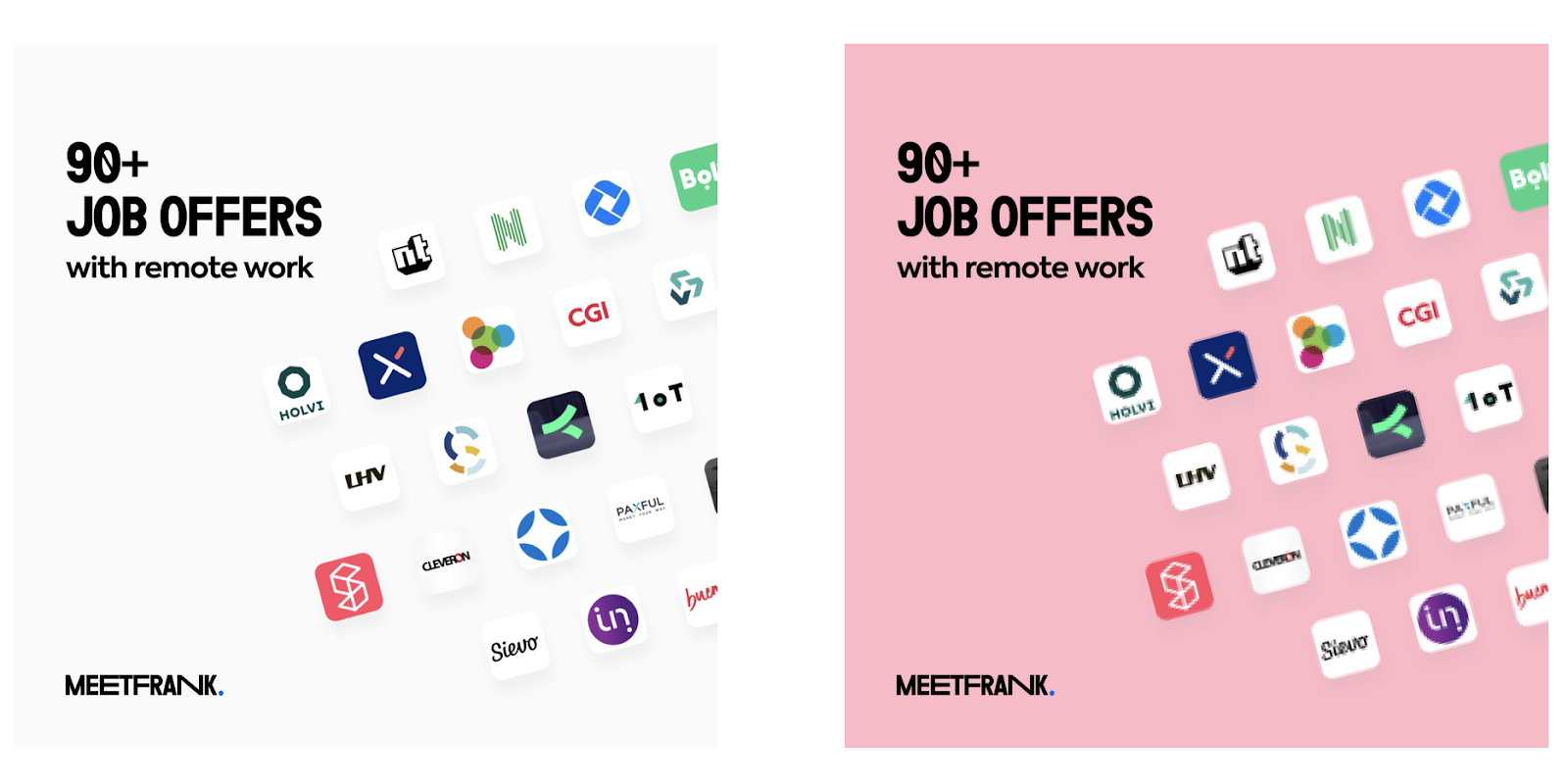
MeetFrank uses different background colors in ads
In addition to playing around with colors, you can also use different ad layouts.
The ad below from Asana is a great example. They run a lot of different ads (and this helps to keep their relevance scores higher).
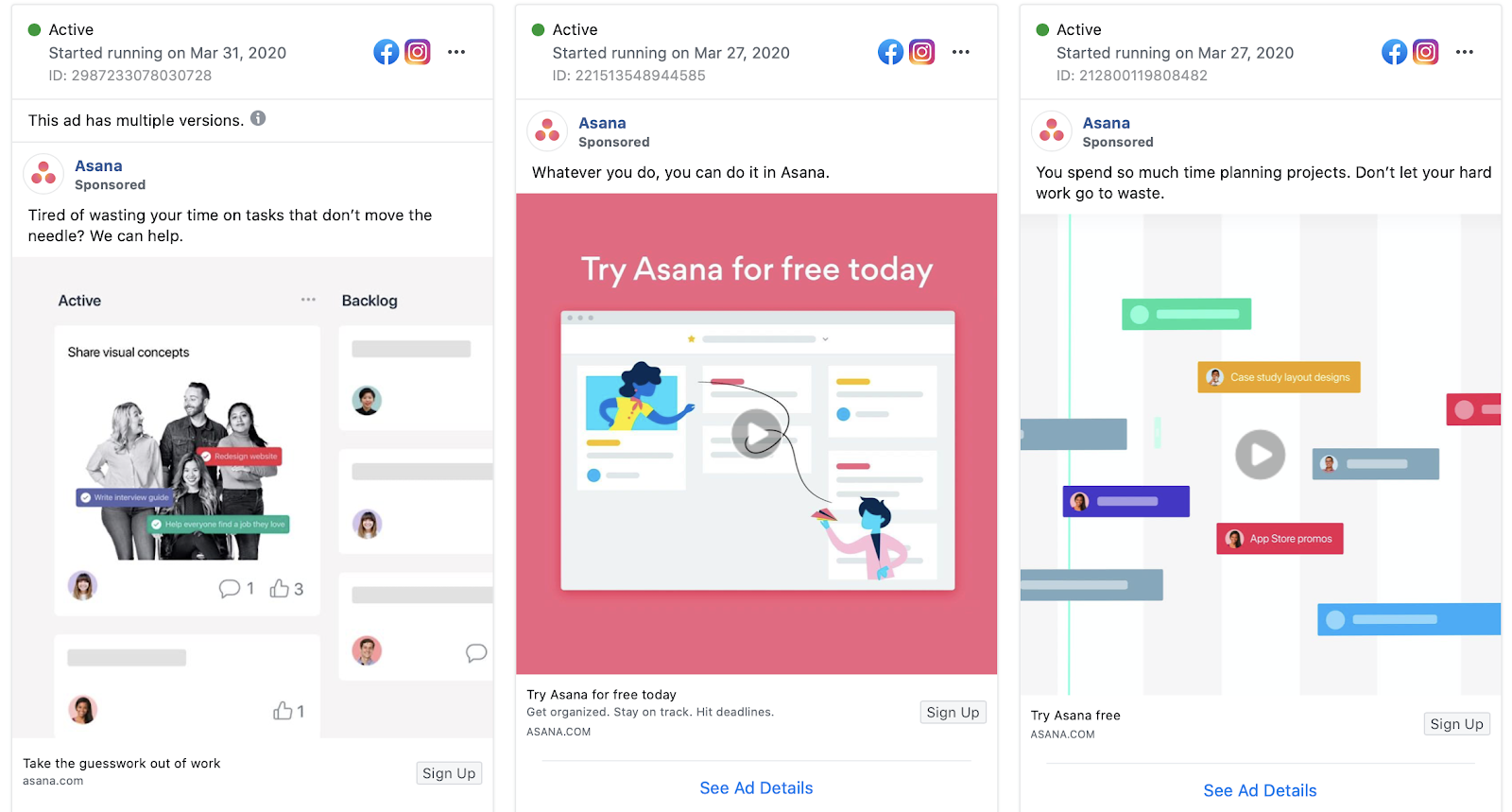
Asana’s ads use bright colors
You can see more examples in Facebook Ad Library
5. Make sure your ads use correct formats for all possible placements
Facebook has A LOT of different ad placements where your ads might appear.
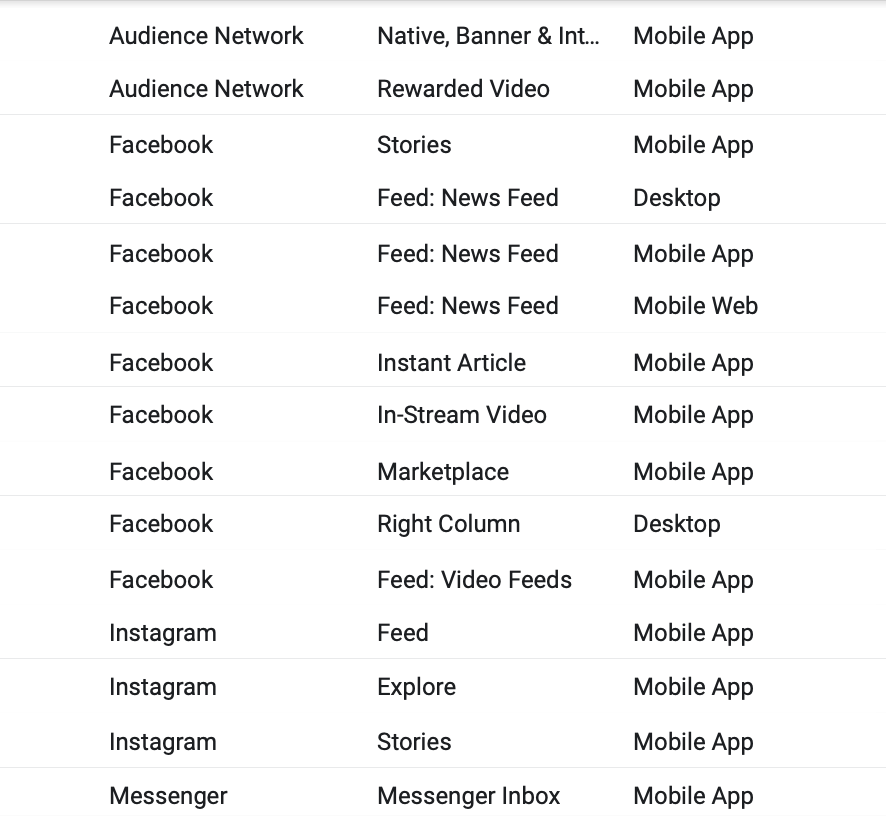
Various Facebook ad placements
And not all of these placements show the ad images in exactly the same measurements.
For example, take Instagram Stories placement. If your campaigns only include ads in the 1200 x 628 pixels size, they’re not going to look very nice. You will need to create a custom size for Stories placements to get better ad relevance scores.
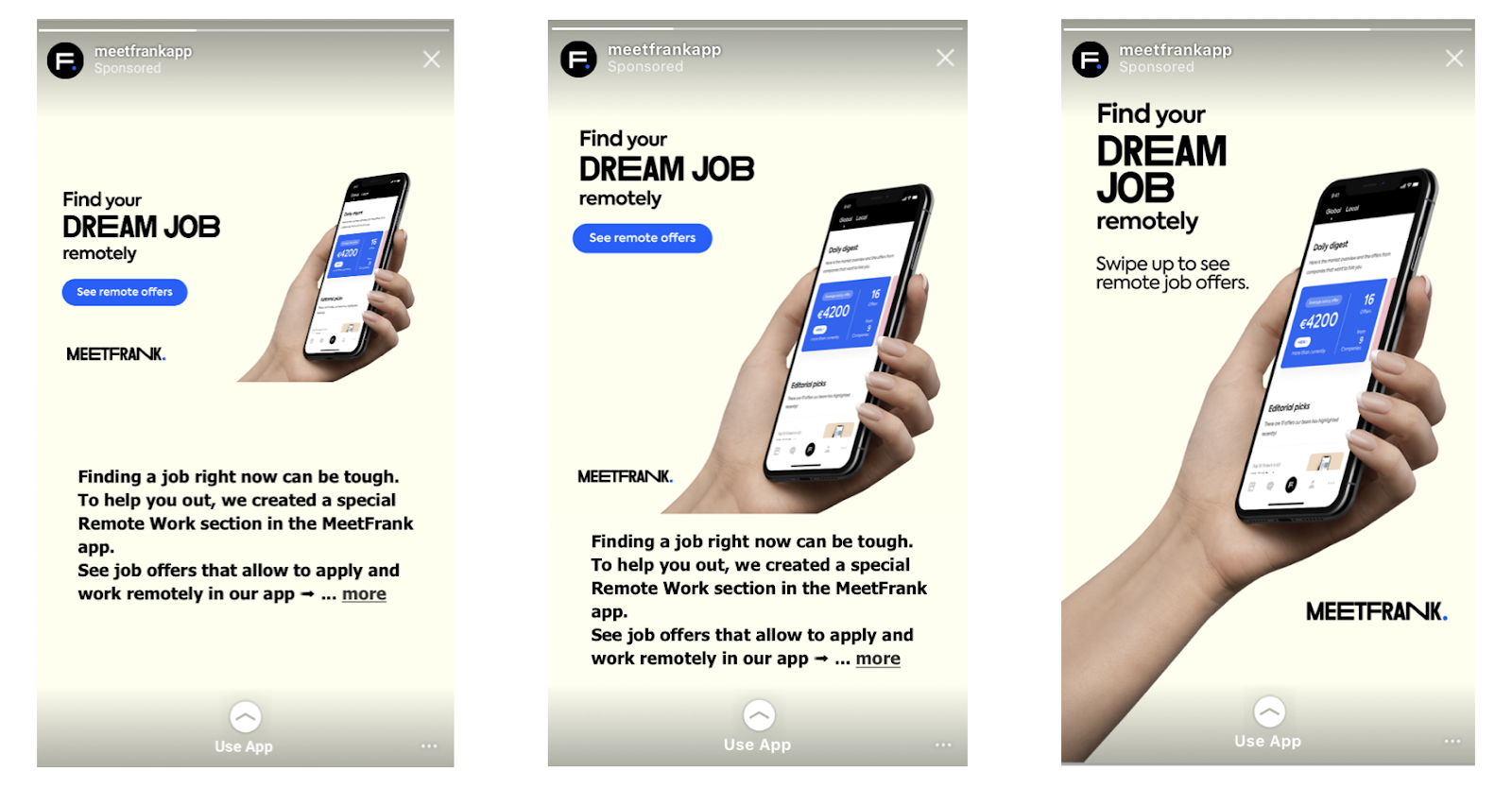
How ads can look in Stories placement – Image source
Here are the top 3 ad sizes that cover all Facebook static image placements:
- Landscape: 1200 x 628 pixels
- Square: 1080 x 1080 pixels
- Portrait: 1080 x 1920 pixels
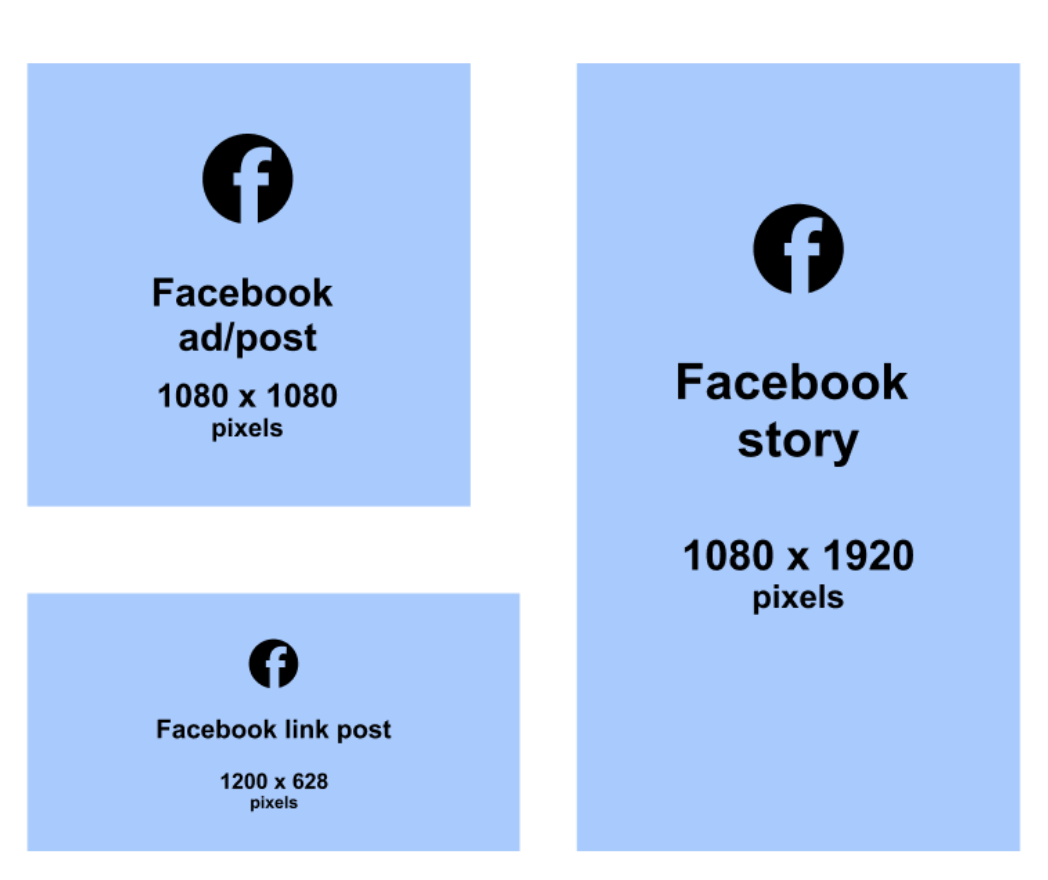
Facebook ad measurements – Image source
We recommend that you create each of your ads in these three formats and add them all to your campaigns, using the Facebook ad placement customization feature.
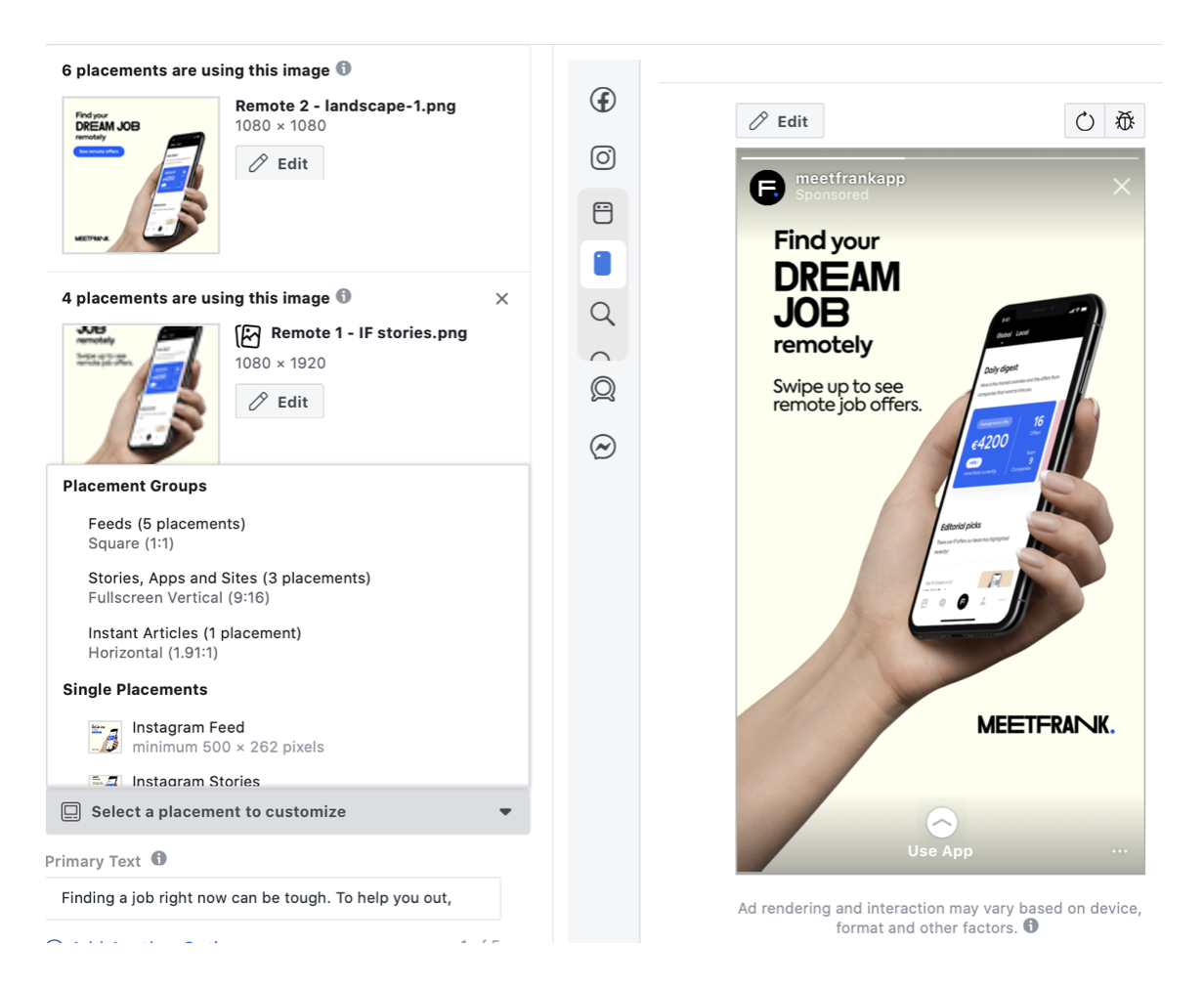
Add 3 different formats of ad images per ad
You can upload multiple image sizes when adding/editing your ads in the Ads Manager. Doing so will help to boost your ads’ Quality Scores across all Facebook ad placements.
6. Double down on your ad creatives with higher quality scores
If you already have some ads that have received the “Above Average” quality ranking, why not take advantage of this and double down on what’s working?
Go to Facebook Ads Manager, review your ads’ relevance metrics, and find the ads with the highest Quality Ranking. Try to analyze what makes them outperform the rest of your ads: is it the messaging or visuals?

Find ads that have “Above average” rating
Once you find the best-performing ads, you can create new alterations of them:
- Test your top-performing ads with a new copy.
- Test your top-performing ads with new illustrations or colors.
- Animate your top-performing static image ads.
For example, the below Slack example is an animated version of one of their static image ads that looks the same.
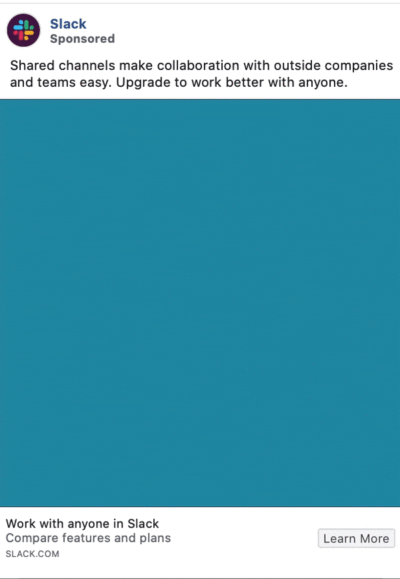
Slack animated their top ads
Pro tip: Once you have added new ad creatives to an ad set, pause the same amount of old lowest-performing ads to help Facebook delivery algorithms learn faster. On top of it, you can drive up your ad campaigns’ Quality Score if you remove the lowest-scoring ad creatives.
7. Try new Facebook ad types
Thus far, we have mainly focused on how you can increase your Facebook ad Quality Ranking by creating better static single-image ads.
However, there are many more Facebook ad types to test out:
- Carousel ads
- Lead ads
- Collection ads
- And many more
For example, the Finnish Design Shop’s ad below is a Collection ad. This format allows you to showcase multiple items in your product catalog, turning a single ad into a highly engaging shopping experience.

This is a Collection ad
Facebook Lead ads allow you to collect leads without having people leave Facebook’s platform. This is a good option if you don’t have a good-looking (and highly converting) landing page.
Facebook Carousel ads make it possible to add up to 10 images into a single ad. This is a good option for marketers looking to show multiple products at once.
As you test out the new Facebook ad types, add the new ads to your existing ad sets, so that they compete with your other existing ads. This way, you can learn which creatives get the highest relevance scores and other quality rankings.
8. Test Facebook video ads
To improve your Facebook ad relevance score, try introducing video ads to your campaign mix.
For example, I was working with a mobile app in the entertainment industry. At first, we were testing static image ads and got quite desperate when seeing the $33 cost-per-app-registration (the ad marked with blue).
Yet after we added video ads, the CPA dripped almost 4x. That’s HUGE.
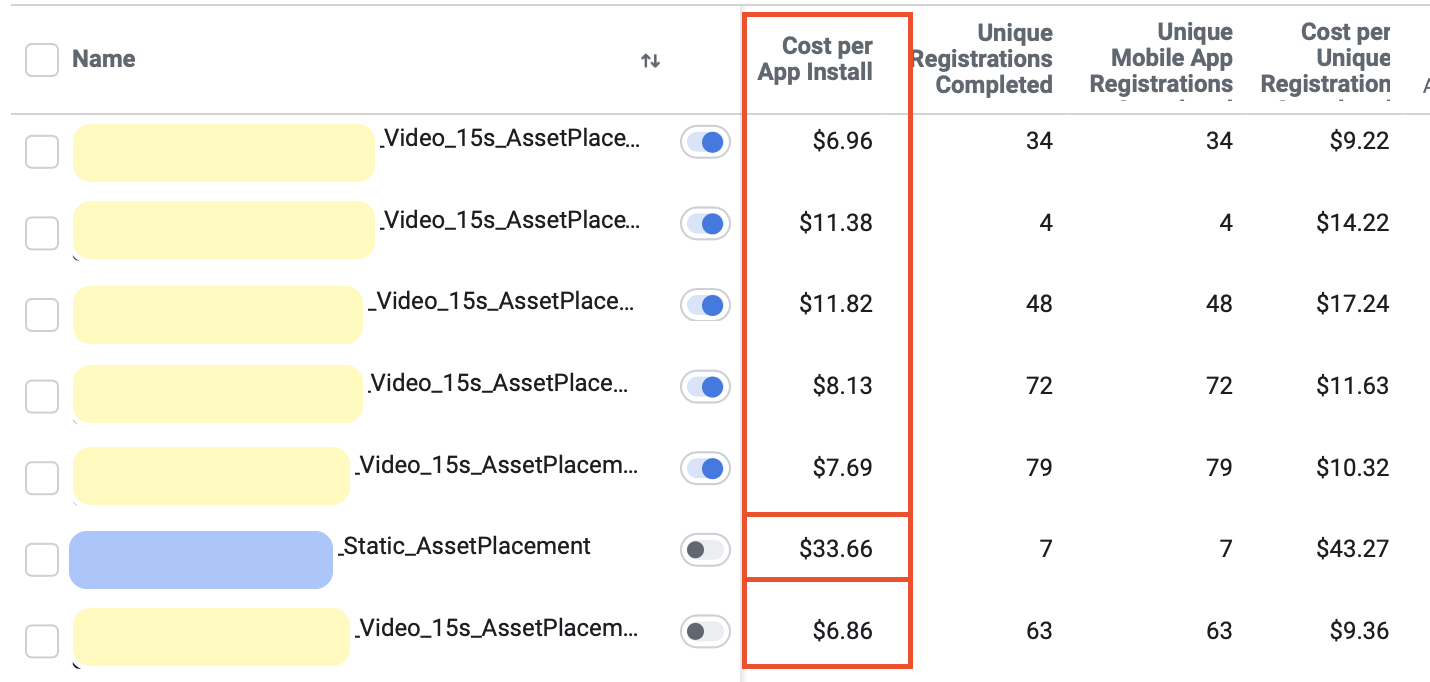
The blue box marks a static image ad
Video ads can help to significantly reduce the cost-per-result of your Facebook campaigns.
You can start out by testing simple animations, but for the best Quality Rankings, create elaborate and fast-paced video creatives like the below example by Cowboy bikes:

An excellent Story video ad example
To make sure your video ads perform well, keep in mind these best practices:
- Capture attention within 2 first seconds.
- Change copy and scenes FAST.
- End the ad with a CTA.
9. Improve your landing page conversion rates
In addition to the ad creative, also the post-click experience contributes to your Facebook ad Quality Score. Meaning that if a user clicks on your ad and lands on a web page that’s uninteresting for them, your ads’ Quality Score might drop.
A poor landing page experience can happen when:
- The landing page loads too slow.
- The landing page fails to draw people’s attention.
- The landing page doesn’t lead people to complete a conversion, e.g. a purchase.
A good landing page layout ensures that the viewer understands what is being sold and gets so excited about the product or service that they complete a signup or purchase.
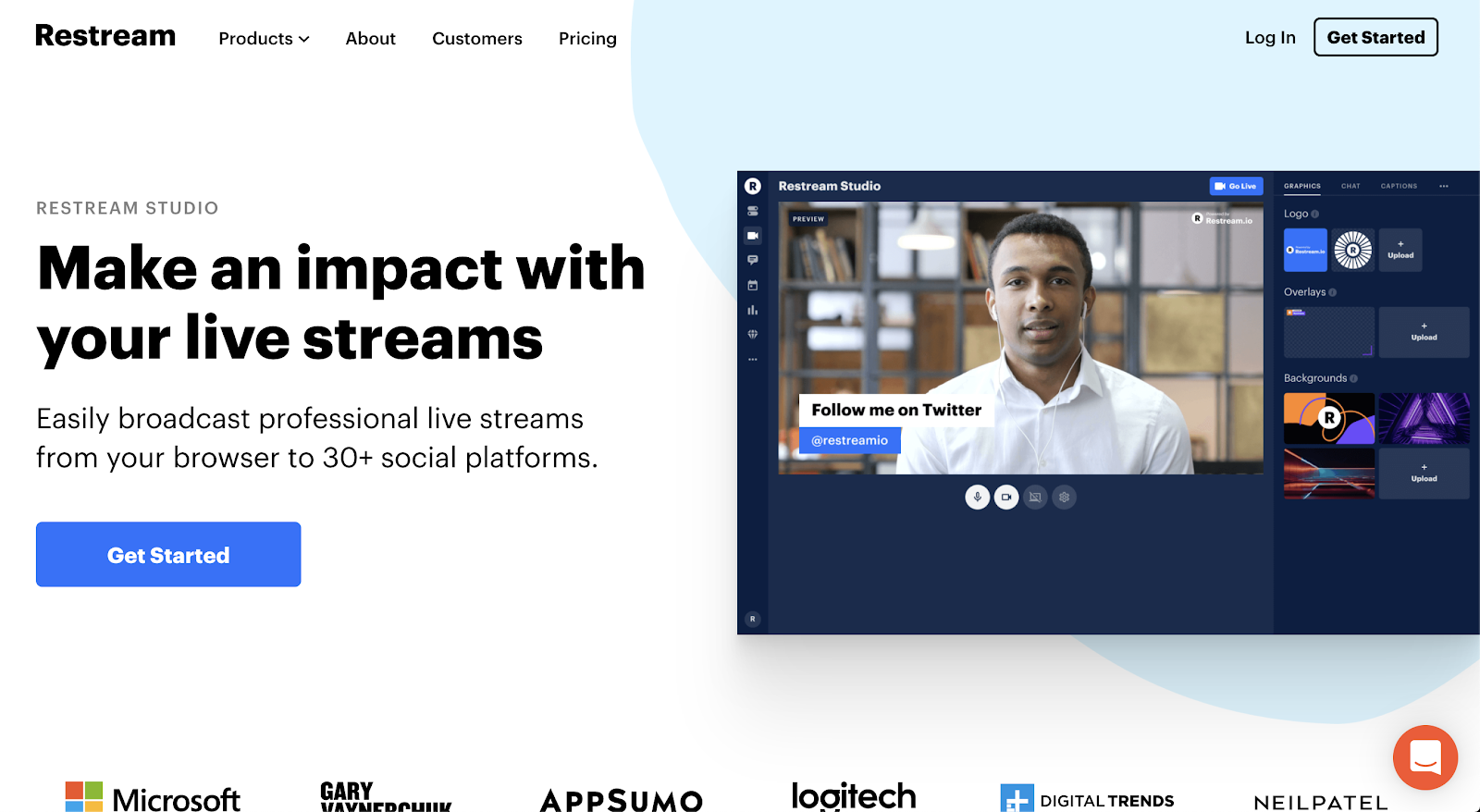
Good landing page hero section example
The most common landing page sections to include are:
- The hero section
- Social proof section
- Features section
- “How it works” section
- Footer section
Make sure that each of these sections has a clear key message and looks attractive to the eye.
For more tips and hacks on how to improve your Facebook ads landing page, see this guide: 35 Landing Page Trends Worth Testing In 2020
10. Make sure your landing page is mobile-responsive
Most of your Facebook ad views happen on mobile devices. Which means that most website clicks also happen on a smartphone screen.
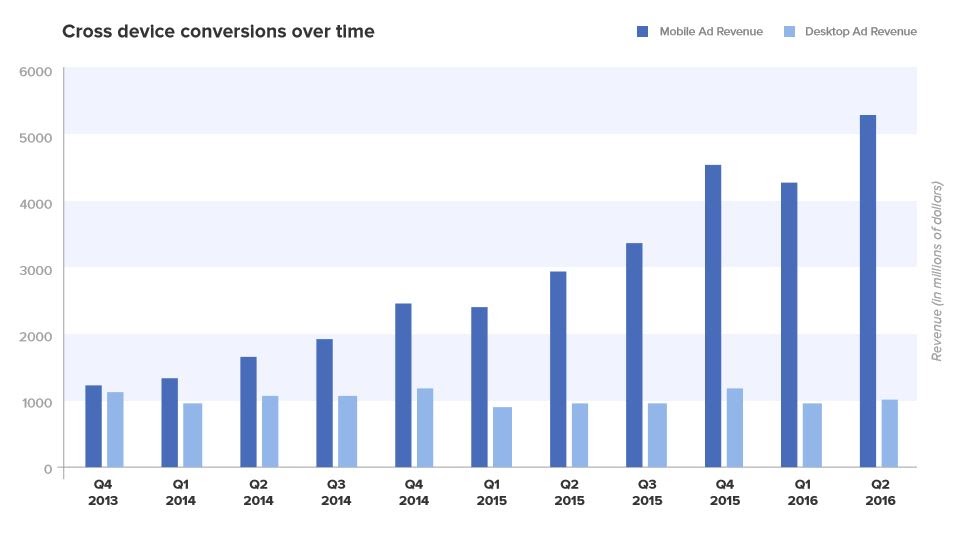
Most Facebook ad views are on mobile devices – Image source
If your landing page conversion rates and time-on-page are not on a strong level, review if your ad landing pages are mobile-optimized.
Also, run a quick page loading speed test with Google’s free PageSpeed Insights tool to find out how to improve your website loading speed further, especially on mobile devices.
Pro tip: A quick way to create good-looking and mobile-responsive landing pages is to use landing page tools like Unbounce.
🤜💥🤛 Alright!
You should now have a fair share of new ideas for improving your Facebook ad Quality Score. Up next, we’ll discuss how to improve your ad relevance further by fixing the Engagement Rate Ranking.
💎 Facebook ad Engagement Ranking and how to improve it
Your Facebook ad campaigns’ Engagement Rate Ranking indicates how much your target audience engages with your ads.
This metric is calculated based on clicks, likes, comments, and shares of your ad. Your ad is ranked against ads that compete for the same audience.
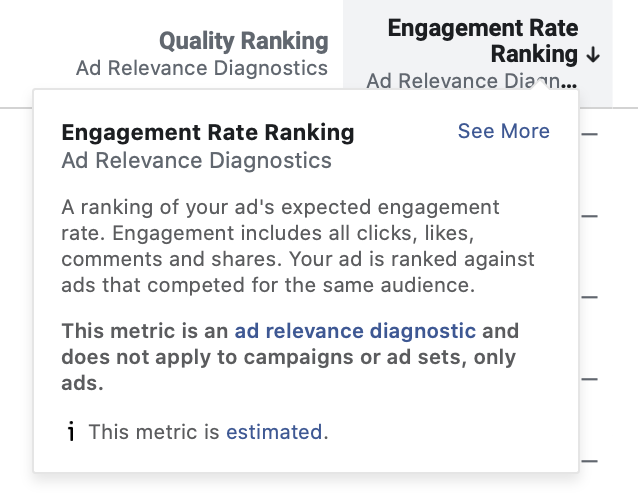
Facebook ad Engagement Rate Ranking
Just like the Quality Score, there are 5 levels of Engagement rate:
- Above average
- Average
- Below average (Bottom 35% of ads)
- Below average (Bottom 20% of ads)
- Below average (Bottom 10% of ads)
To be fair, the steps to improve the Engagement Ranking are very similar to your overall Quality Ranking. After all, your ads’ click-through rate and the way that people engage with them depends on its creative quality.
There is one more clever hack to improving your ad’s engagement rate and it involves collecting as much social proof under a single ad as you can. 😉
Use dark posting to improve your Engagement Ranking through social proof
When setting up Facebook ad campaigns, you may want to target multiple audiences. For that, you would need to create different ad sets, each with its own ads.
However, setting up the same ad creative the traditional way across 10 ad sets will create 10 unique post IDs. And each of these ads will start collecting their own likes and shares.
What if instead of 10 identical ads that all have 10 likes, you could have the exact same ad with all the amassed comments and likes inside all of your ad sets?
It’s possible with the hack called Facebook dark posts. 😈

Like scooping up all the likes and social proof – Image source
Dark posts are posts (or ads) with unique post IDs that aren’t live and can’t be found organically. However, you can use them across multiple ad sets with one unchanged ad ID.
Follow these steps to use the same ad in multiple ad sets and collect more likes and shares under it for higher Engagement Rate Ranking:
1. Create a new Facebook ad in one of your ad sets.
Follow the regular ad creation process in the Facebook Ads Manager.
2. Find the new Facebook ad’s ID.
For this, navigate to the Ads Manager, open up the ad in a new window, and copy its’ ID from the URL. See the step-by-step guidelines here.
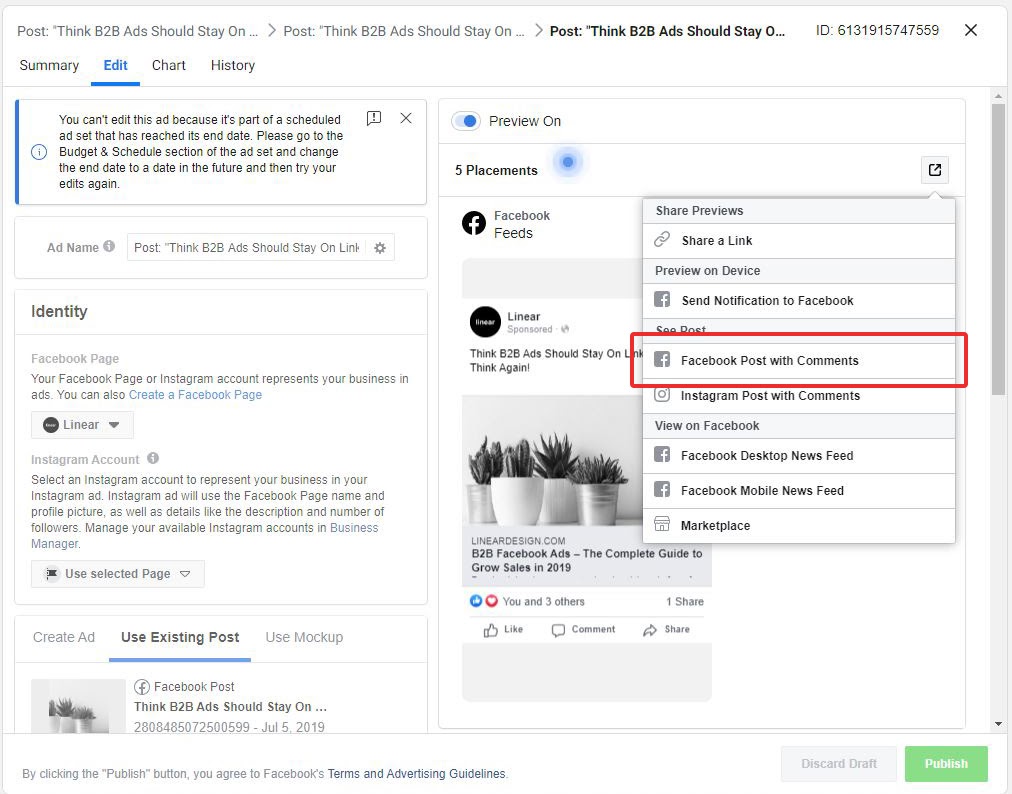
Select “Facebook Post with Comments.”
3. Add the ad with the correct ID to your other campaigns as well.
For this, navigate to relevant ad sets, click on “Create new ad,” use the “Select a Page Post” option, and enter your new ad’s ID.
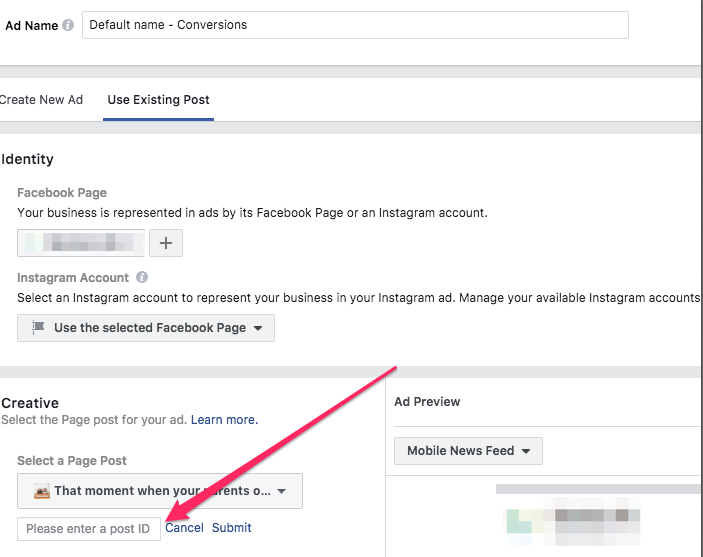
Enter your post ID
By using the same ad ID across multiple campaigns and ad sets, you will end up with a Facebook ad that has hundreds of likes under it.
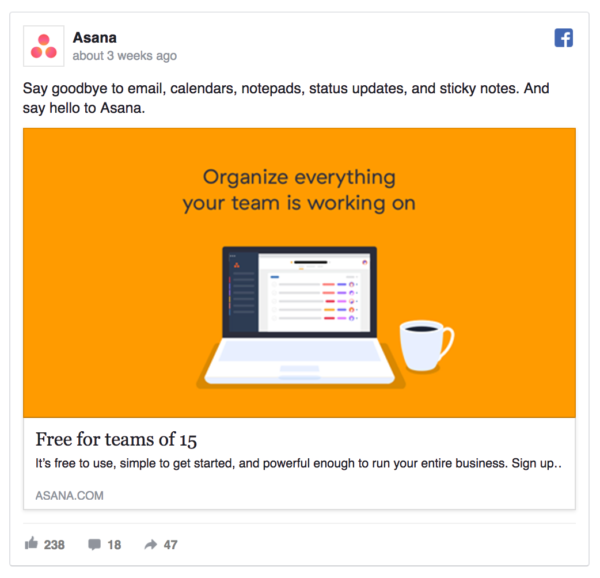
This Asana ad has lots of likes, comments, and shares.
By having more likes under your Facebook ad, you will also get more clicks as people are more likely to trust your brand. 🚀
Now that we have already learned how to evaluate and improve two of the Facebook ad quality metrics. There’s just one more left to tackle – the Conversion Rate Ranking.
Bear with us to learn the most efficient audience targeting and campaign optimization hacks for higher Facebook ad relevance!
💎 Facebook ad Conversion Rate Ranking and how to improve it
Your Facebook ads’ Conversion Rate Ranking estimates the probability of achieving your ad optimization goal against ads with the same optimization goal competing for the same audience in the ad auction.
Pretty complex, huh? Bring back the good old Facebook relevance score? 😅
Put simply, the Conversion Rate Ranking tells you how likely your ad is to bring conversions, be it website signups, online store purchases or mobile app installs.
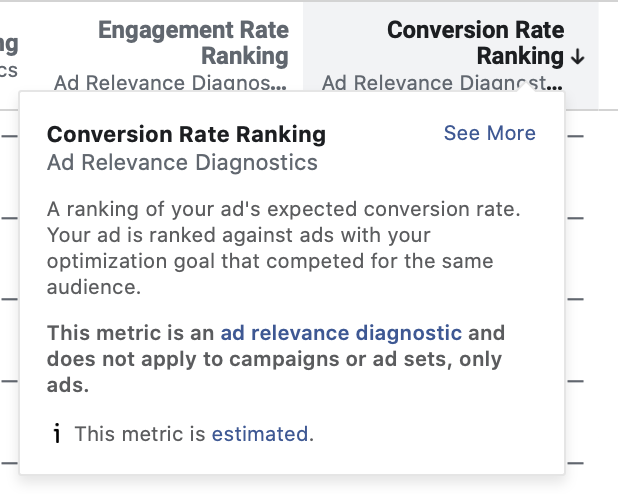
Facebook ad Conversion Rate Ranking
And again, there are 5 levels of Conversion ranking:
- Above average
- Average
- Below average (Bottom 35% of ads)
- Below average (Bottom 20% of ads)
- Below average (Bottom 10% of ads)
If at least one of your ads in every ad set has a Conversion Rate Ranking on the level of Average (or Above average), you’re already doing quite well.
But what if all your ads have a Below average score? This calls for a remedy! Which leads us to the following advice… 👇
8 targeting and optimization tips to improve your Facebook ads’ Conversion Rate Ranking
While your Facebook ads’ Engagement score is calculated based on how the audience interacts with your ad, the Conversion rank score is more directly linked to your offer’s relevance to the target audience and their post-click activity.
To improve your Facebook ads’ Conversion Rate Ranking, you will need to make sure there’s a strong audience-offer match and that your ads and landing page are properly conversion-rate-optimized.
Apply these Facebook ad targeting and campaign optimization suggestions to improve your Facebook ads’ Conversion score:
- Target Lookalike audiences of your top customers.
- Set up remarketing campaigns that reach higher relevance scores.
- Keep your ad frequency under 5 views per week.
- Expand your ad set audience if you need to scale the results.
- Optimize your ad campaigns on conversions instead of reach or clicks.
- Make sure each ad set reaches 50+ conversions per week.
- Lower your ad budgets to avoid overpaying for ad impressions.
- Localize your ad campaigns into the local language.
All of these best practices are meant for improving the results of existing campaigns. If you’d like to learn more about the basics of Facebook campaign setup, check out this guide.

Here’s to improved Facebook ad results – Image source
1. Target Lookalike Audiences of your best customers
As you set up a new Facebook ad campaign, you are likely to start out with 1-2 ad sets that target a broad interest-based audience of people living in a specific country.
However, don’t miss out on one of the most powerful Facebook targeting features: Lookalike audiences.
These special Facebook audiences help you to reach people with similar interests and habits as your existing high-value customers. This means that your ads will reach people who are more likely to complete a purchase (or another conversion event).
To create a Lookalike audience, you will first need to create a “seed” audience – a Facebook Custom audience that you want the people in Lookalike audience to resemble.
There are three main options for creating the seed audience for a Lookalike audience:
- Upload your top customers’ data to Facebook manually.
- Create a custom audience based on Facebook Pixel events.
- Create a custom audience of top x% or high-value purchasers from Facebook Pixel data.
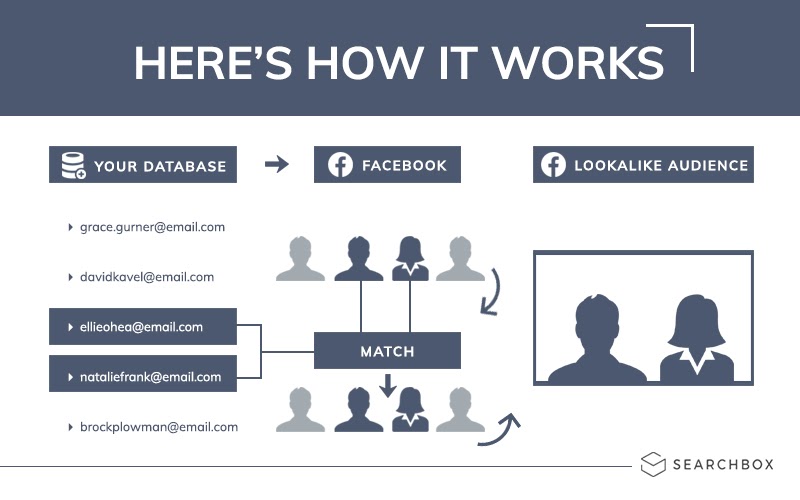
How the Lookalike audiences work – Image source
To create a Lookalike audience:
- Create a Facebook Custom audience (the seed audience)
- From this Custom audience, create a Lookalike audience
We recommend to test out adding ad sets with 1% and 5% Lookalike audiences to your Facebook ad campaigns.
Here are 3 ideas for creating high-value Lookalike audiences to get you started:
- Create a Lookalike audience of people who have completed a purchase in the past 60 days.
- Create a Lookalike audience of your 10% top-paying customers.
- Create a Lookalike audience of people who have finished some other valuable conversion event (like signup, or added items to cart).
Extra tip: You can upload multiple new ad sets to your Facebook campaigns to test out several Lookalike audiences at once.
2. Set up remarketing campaigns to reach higher relevance scores
In most cases, Facebook remarketing ads have a higher Quality score than regular broad targeting ad campaigns as the audience is already aware of your brand and product.
According to statistics listed by CMO.com, remarketing ads have a click-through rate that’s up to 10x higher than that of regular ads.
Moreover, retargeted people are 70% more probable to convert compared to cold audiences.
By adding various remarketing ads to your Facebook campaign mix, you can drive up both the relevance score and drive more sales.
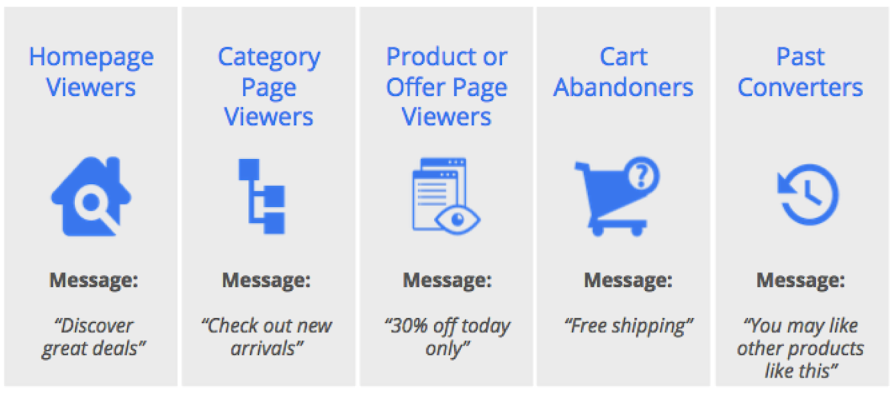
Remarketing audience ideas – Image source
The most common remarketing tactic is to show additional ads to visitors who have viewed your site in the past 15 or 30 days.
However, you can also create Facebook remarketing campaigns that target past purchasers to invite them back to your online store and buy more items.
Pro tip: To boost your remarketing ads’ Conversion ranking even further, include special offers such as:
- Offer x% off the next purchase.
- Offer x% off for a limited time.
- Offer $100 off all orders over $500.
- Offer a discount on specific product lines.
For example, Restream is using ads with a special promo code to nudge people to start their paid subscriptions.
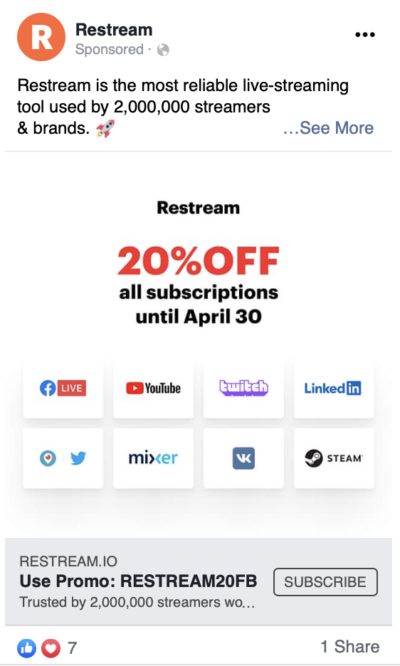
Restream offers a 20% discount
Here’s another example by Airbnb, dynamically remarketing to a person that has previously searched for Paris apartments on their website.
The more hyper-targeted your remarketing ads are, the higher Engagement and Conversion Rate Rankings you’ll get.
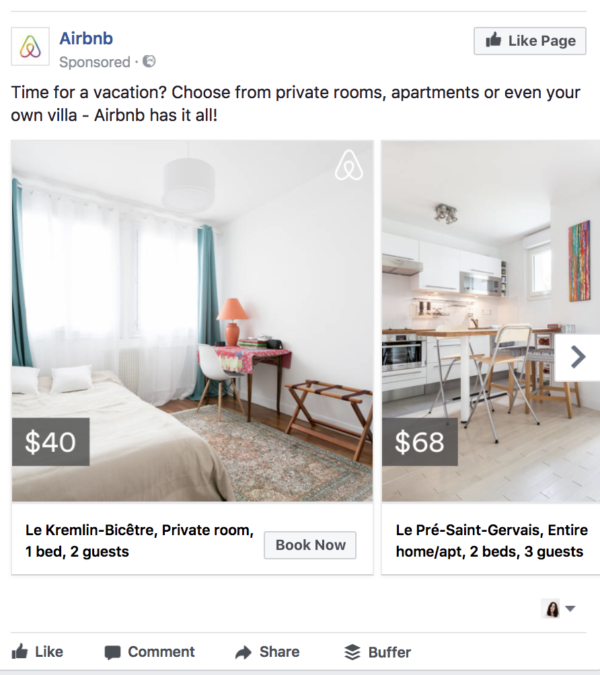
Airbnb remarketing ad
Extra tip: By adding a time limit to your special offers you can create a sense of urgency and push people to make the decision faster.
For example, you could limit your discount offer to 10 days or a month to accelerate sales.
To set up a remarketing campaign on Facebook, create a Custom Audience of the people you want to target and set up a new campaign with it.
P.S. Do not add remarketing ad sets into cold campaigns, especially if you are using campaign budget optimization. – This will lead Facebook algorithms to allocate too much budget to the remarketing ads (as they bring the most results) and will drive your ad frequency way too high.
3. Keep your ad frequency under 5 views per week
Facebook ad frequency is a metric that shows how many times people have seen your ad in a set period of time.
The higher your ad frequency, the more people in your target audience have seen the same ads over and over again. And, well… If you see the same ad for more than 5 times, you are unlikely to keep clicking on it.

Arghh, not that ad again… – Image source
AdEspresso analyzed how ad frequency affects the ads’ click-through rate, CPC, and cost-per-conversion. They found out that it affects results big time.
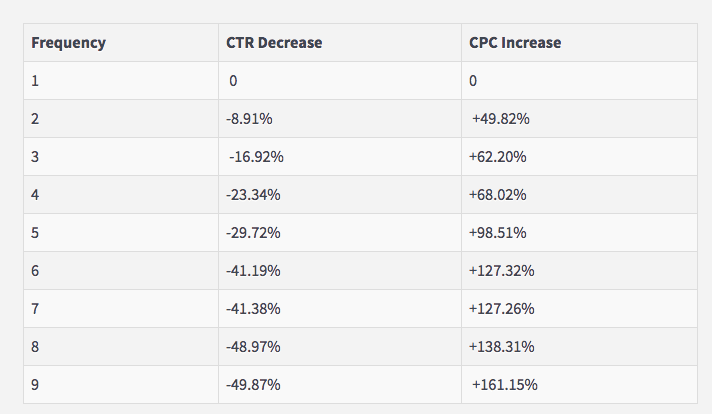
High ad frequency leads to lower ad relevance – Image source
When people saw the same ad 2x, the ad’s click-through-rate decreased by 8.91%. And when shown similar ads for 5 times, the cost-per-click was 98.51% higher than at the first ad view.
If your Facebook ad Quality Score is low, review your past 7 days’ ad frequency:
- Go to the Facebook Ads Manager.
- Select the timeframe of the past 7 days.
- Set your report’s “Columns” to show “Delivery” metrics.
- Review the frequency of all ad sets and dive in to see individual ads’ frequency.
- If the frequency is too high, make changes to your campaign.
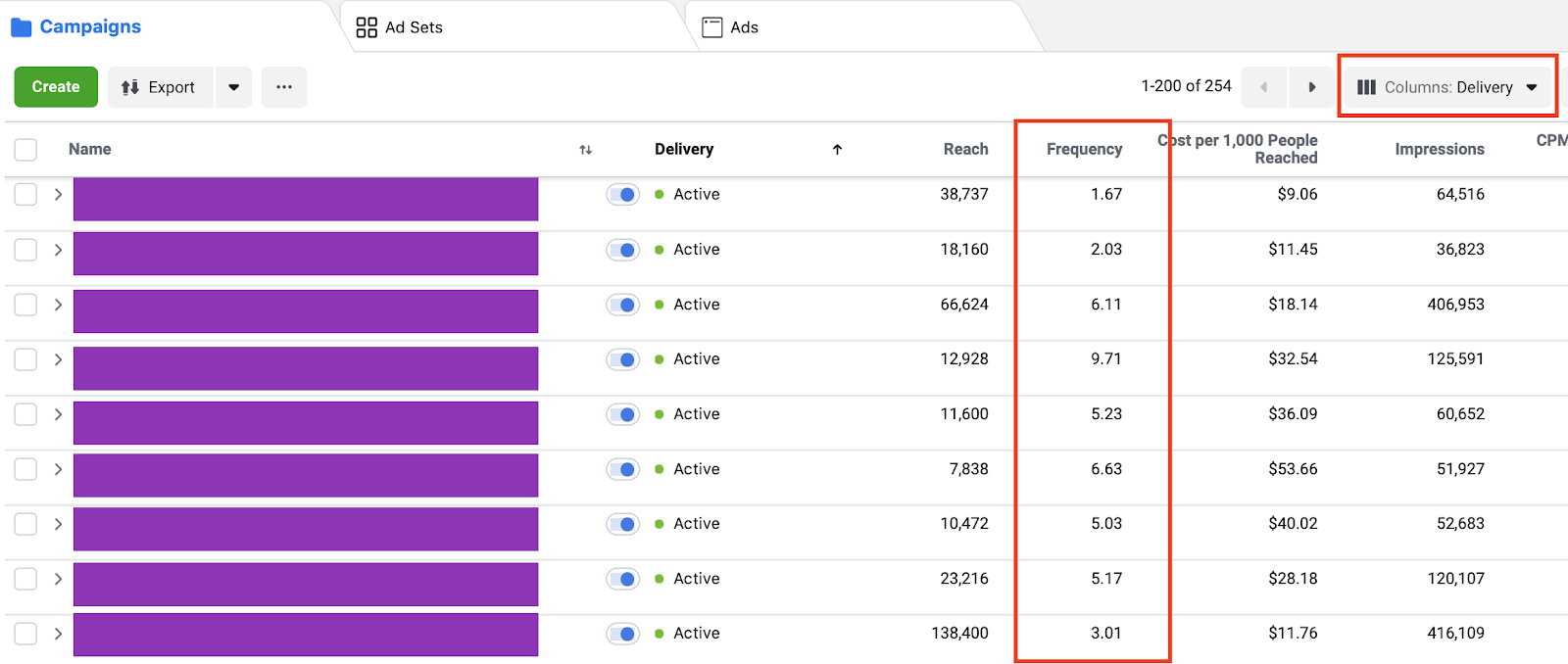
Facebook ad frequency
But what is the optimal Facebook ad campaigns’ frequency and when should you start to edit your ad sets to lower the ad views per audience member?
- Broad targeting Facebook campaigns: If the ad sets in your broad targeting campaigns have a frequency higher than 5.0 points, it’s an indicator that you should increase your target audience size or lower your budget.
- Facebook remarketing campaigns: It’s a little bit different story when it comes down to remarketing. It is alright if your Facebook remarketing ad sets have a frequency of 5-15 points as you want to reach those warm audiences more frequently.
4. Expand your ad set audience if you need to scale the results
If you’re getting good results with your Facebook campaigns, you’re going to want to scale them.
⭐ Higher budget = more people reached = more results = more profit.
However, it is not always that easy…
If you simply increase your Facebook campaigns’ budget, it may happen that you get the same number of results, but at a higher cost. And on top of that, your Quality Score and Conversion Ranking will drop as well.

You’ can’t scale without a proper plan – Image source
The most foolproof way to scale your campaign results successfully is to update multiple aspects of your campaigns at once:
- Increase the ad budget of top-performing ad sets gradually, by 20% after every 24h.
- Broaden your target audience to avoid reaching high ad frequency.
- Add new ad visuals to your campaigns, so that people will be more engaged when they see new interesting visuals and offers.
Extra tip: Once you have made the changes to your ad campaigns, let them run at least for 48h before making any definitive results about the changes in performance.
5. Optimize your ad campaigns on conversions instead of reach or clicks
As you set up your Facebook ad campaigns and later on the ad set level, there will be plenty of campaign optimization options available: reach, traffic, conversions, sales, leads… The list is long.
Your campaign’s optimization method will also have an effect on your ad relevance scores as it defines which part of your target audience you’re going to reach.
So you better choose it wisely!
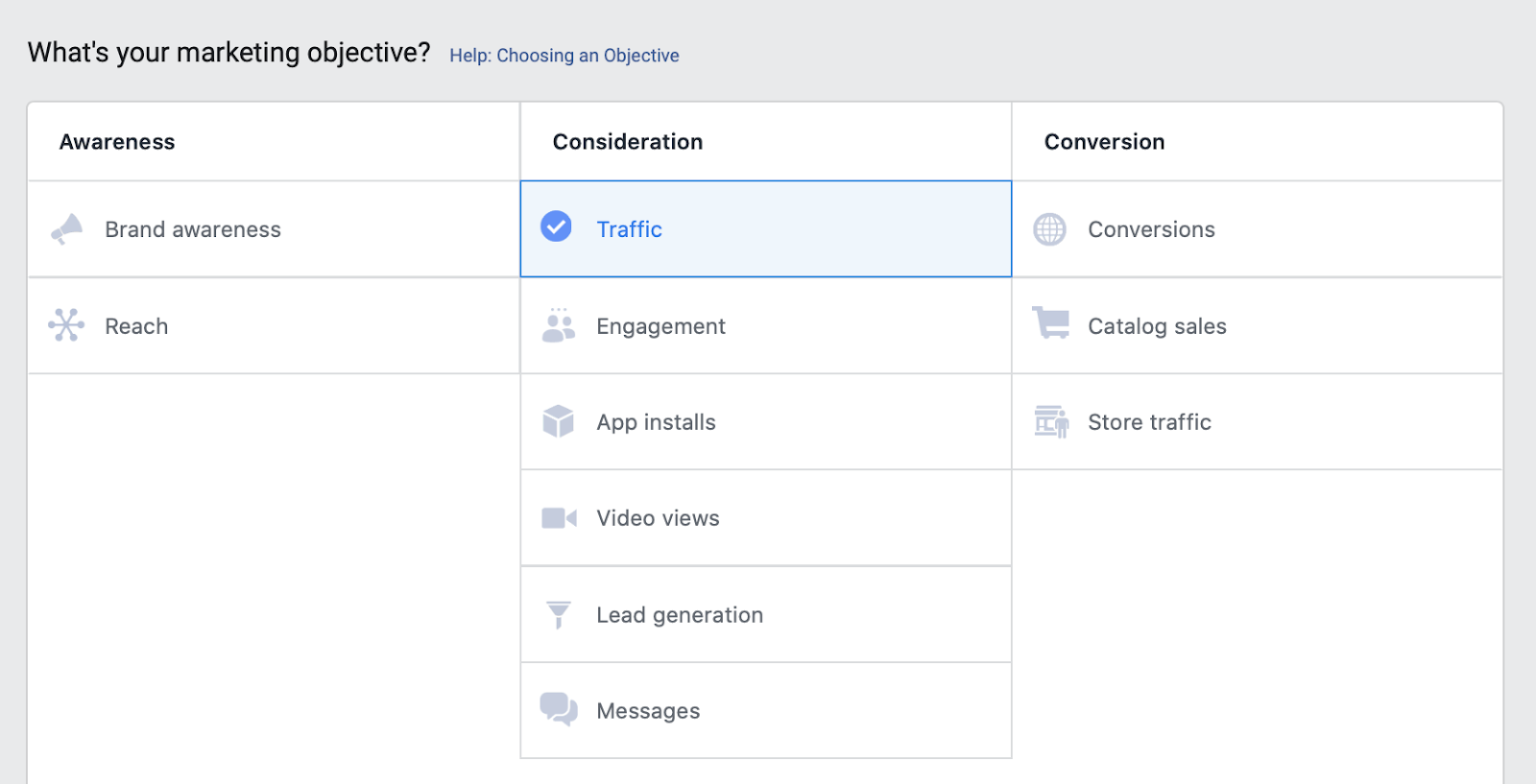
Which one should you pick?
If your goal is to drive sales on a website or collect leads, we recommend to:
- Select the Conversions campaign objective.
- On ad-set level, optimize your ad delivery on Signup or Purchase events.
As you optimize your ad delivery on conversions, Facebook’s algorithms will show your ads to people most likely to complete the goal.
This means that you’re going to reach an engaged audience that your ads are relevant to.

Reach people that want your product – Image source
P.S. to be able to optimize your Facebook campaigns on conversions and to measure the results in Ads Manager, you will need to have the Facebook Pixel installed on your web page.
If for some reason you’re unable to optimize your campaigns on conversions, try Landing Page View ad delivery optimization instead. And as the last resort, optimize on clicks (really not recommended, install the Facebook Pixel whenever possible).
6. Make sure each ad set reaches 50+ conversions per week
As you start to run Facebook ad campaigns that are optimized on conversions, they will at first enter the “Learning phase.”
The learning phase is the period when the Facebook ad delivery system is learning about an ad set.
The learning phase usually ends after an ad set reaches 50 optimization events since its last significant edit.
Until the first 50 conversions, your ads may have worse results and Quality Score as the algorithms are still defining the best target audience to show your ads to.
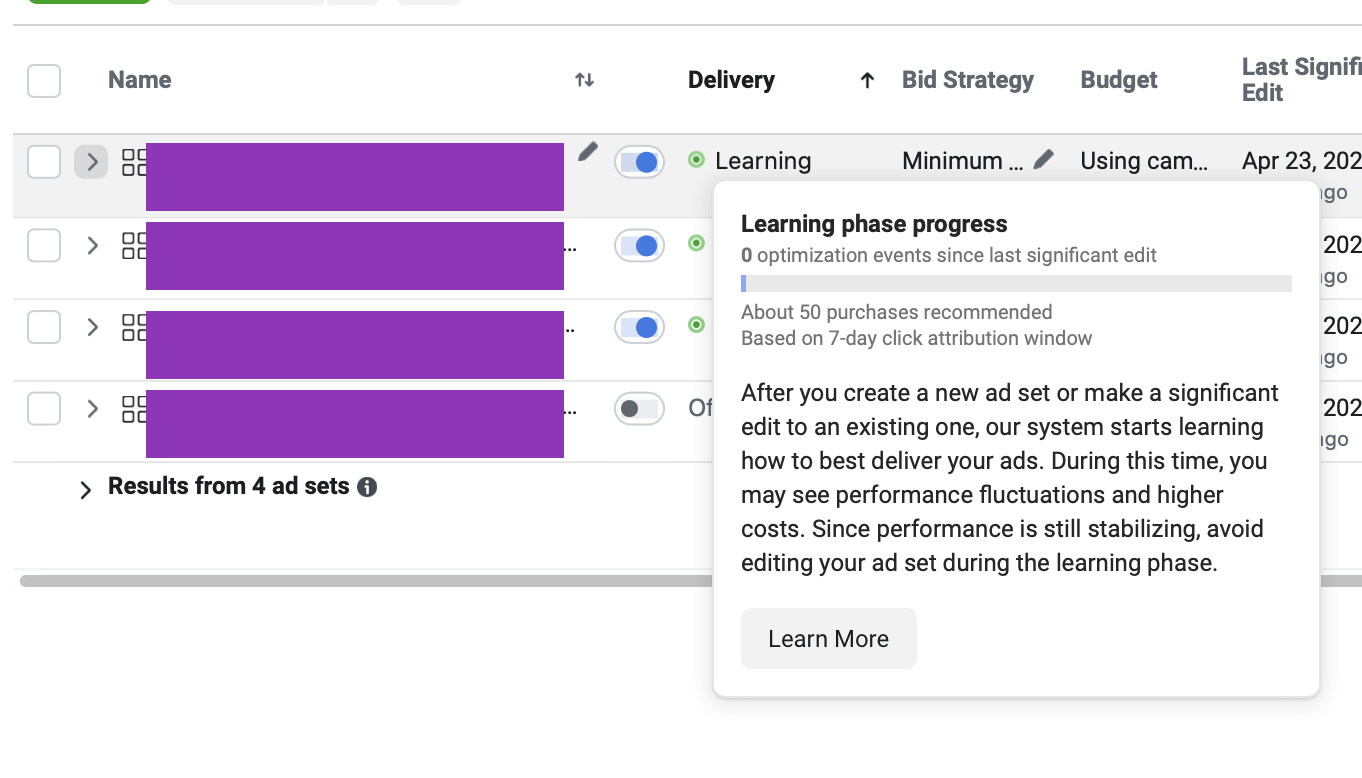
Learning phase ends after 50 optimization events are achieved
To make sure that each of your Facebook ad sets reaches the end of the learning phase faster, follow these tips by Facebook:
- Wait to edit your ad set as far as it’s out of the learning phase. By editing an ad, ad set or campaign during the learning phase, you will reset learning and delay Facebook’s delivery system’s ability to optimize.
- Avoid unnecessary edits that cause your ad sets to re-enter the learning phase.
- Avoid high volumes of different ads and campaigns. When you create many ads, the delivery system learns less about each ad and ad set than when you create fewer ads.
- Use realistic budgets. Set a budget large enough to get at least 50 total optimization events and avoid frequent budget changes.
Here’s an extra tip: When setting up your ad campaigns, instead of running 5 different campaigns per country, create one cold targeting and one remarketing campaign per country and keep the number of ad sets between 2-3.
This way, you will get a well-optimized campaign with higher ad relevance scores faster.
7. Lower your ad budgets to avoid overpaying for ad impressions
If your ad campaigns’ cost-per-conversion is too high, test lowering your budgets for 72h. There’s a chance that you will get the same amount of results at a lower cost.
How to decide whether you should lower ad budgets?
- Review your ad frequency of the past 7 days: If it’s higher than 5 points, you’re likely to over-deliver your ads.
- Review the historical campaign performance. If your cost-per-result has been going up, cut the budgets to keep the CPAs under control.

Take some money out of your Facebook campaigns – Image source
Lowering your ad budgets doesn’t necessarily mean that you can’t spend more on Facebook ads and get additional results.
Use the extra budget to set up an ad campaign in another market or invest the saved budget into creating improved ad creatives.
As a side effect of lowering your ad budgets and delivery frequency, your ads will reach less non-interested people and will have a higher Quality Score.
8. Localize your ad campaigns into the local language
If you’ve reached this point in this article, here’s a small gift: a secret hack that many (especially US-based) advertisers tend to neglect: translating your ads for your biggest markets.
Localized Facebook ads have significantly higher Quality Ranking as people engage more with ads that are in their own language.
MeetFrank tested out Facebook ads in English vs local language in Estonia, Lithuania, and Finland. In each market, the local language versions had 60-80% higher CTRs. Which, if you scale it up to thousands in ad investment, is huge…
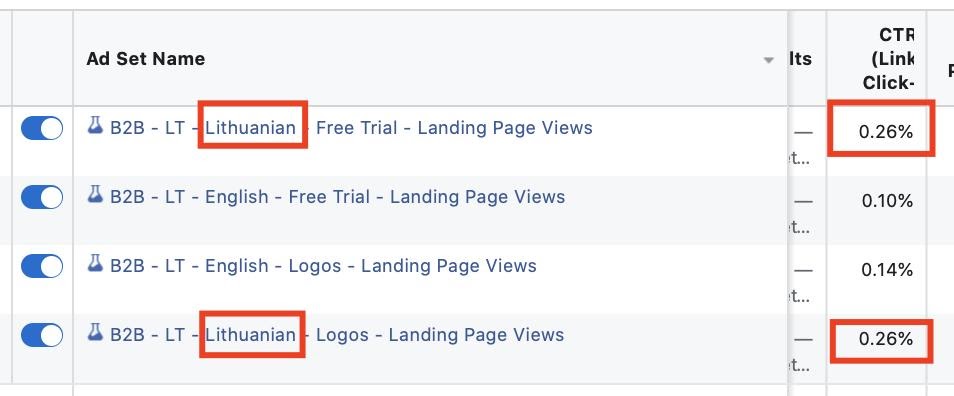
Localized ads had 2x higher CTRs
The ads that they tested looked identical and included the exact same copy. It’s the language that made all the difference.

Test translating your ad to local language
But is localization worth it? Should you also prepare a different brand and messaging strategy for each market? After all…
- It takes time to collect translations.
- It takes time to localize all the ad creatives.
- It would take 10x more time to create ads with different messaging for each market.
If you’re marketing a widely used B2C product (e.g. food delivery apps, online stores), having only English-language products and ads will limit your potential user pool to young tech-savvy people. So it would make sense to localize your ads (and maybe also the product).
You can get away with an English-only B2B service/SaaS product, but even SaaS tools like Slack localize their product for all the key markets.
🏆🏆🏆 You have reached the end of this guide, and hopefully, you’ve come out with new know-how about Facebook ad Quality Score and Ad Relevance Diagnostics.
Remember that when you hear someone mentioning the Facebook ad relevance score, they most likely mean the old ad quality metric of 1-10 points. You can let them know that now, it’s called the Quality Score. 😉
Quick recap
This article is so loaded with tips that we figured it would be helpful to collect them. – So that it’s easier for you to take the newly learned hacks and improve your Facebook ads Quality Score.
Ok, so here we go… To improve your Facebook ads’ Engagement and Conversion rankings, follow these suggestions:
- Improve your Facebook ads’ copy and value proposition.
- Experiment with various discounts and limited-time offers.
- Add more call-to-actions into your ad creative.
- Test out new visual layouts and colors in your ad images.
- Make sure your ads are in the correct format for all possible placements.
- Double down on your ad creatives with higher quality scores.
- Give a try to new Facebook ad types.
- Test out Facebook video ads.
- Improve your landing page conversion rates.
- Make sure your landing page is mobile-responsive.
- Target Lookalike audiences of your top customers.
- Set up remarketing campaigns that reach higher relevance scores.
- Keep your ad frequency under 5 views per week.
- Keep your remarketing campaigns’ frequency under 10-15 views per week.
- Expand your ad set audience if you need to scale the results.
- Optimize your ad campaigns on conversions instead of reach or clicks.
- Make sure each ad set reaches 50+ conversions per week.
- Lower your ad budgets to avoid overpaying for ad impressions.
- Invest the remaining budget into creating new better ad creatives.
- Localize your ad campaigns into the local language.
If you want to learn more about Facebook advertising, check out our other guides:
Luke Heinecke
Founder/CEO
Luke is in love with all things digital marketing. He’s obsessed with PPC, landing page design, and conversion rate optimization. Luke claims he “doesn’t even lift,” but he looks more like a professional bodybuilder than a PPC nerd. He says all he needs is a pair of glasses to fix that. We’ll let you be the judge.
Leave us a comment.
Subscribe to our blog
Subscribe to our blog
Get weekly PPC & CRO advice sent straight to your inbox.